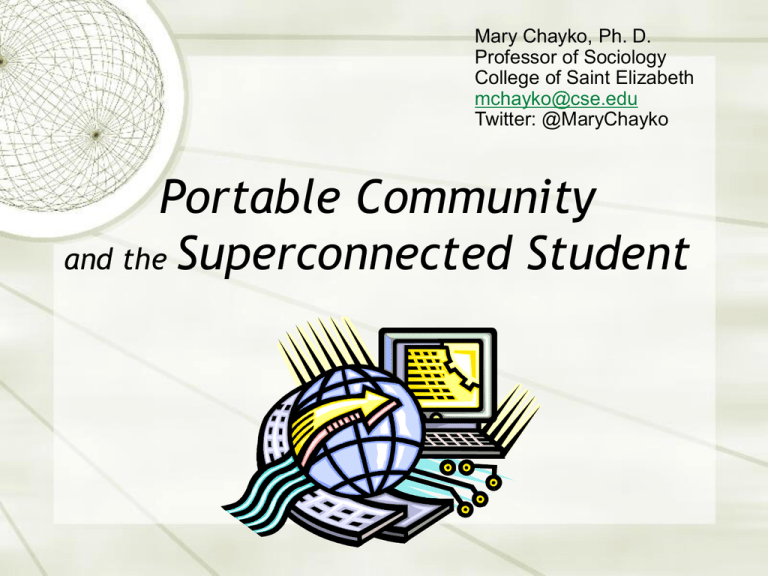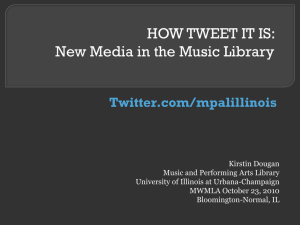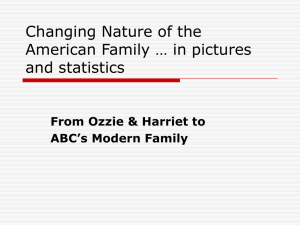Portable Community and the Superconnected Student
advertisement

Mary Chayko, Ph. D. Professor of Sociology College of Saint Elizabeth mchayko@cse.edu Twitter: @MaryChayko Portable Community and the Superconnected Student My longstanding interest in media/communication Undergraduate communication and psychology major; worked at Seton Hall’s radio station WSOU Spent seven years in the radio industry full-time as newscaster, copywriter, disc jockey, and producer (WCTC/WMGQ/New Brunswick, WDHA/WMTR/Dover, WNEW/New York) Noticed and was fascinated by what seemed like strong and definite bonds developing between listeners and broadcasters, especially DJs Attended grad school part-time (Rutgers) during this period studying psychosocial effects of media use Became so interested in topic I decided to pursue Ph.D. full time; remained in radio/voice-over announcing part-time thereafter My early work in the sociology of communication Dissertation research (Rutgers Department of Sociology): Can we form genuine social bonds and communities with people we have never met face-to-face, and if so, how? What is the nature of these bonds and communities and people’s experiences within them? Conducted qualitative research: interviewed 50 people face-to-face, half computer-savvy, half much less so – and integrated findings within an extensive interdisciplinary review of literature Last-minute addition to methodology: 143 short online surveys with internet users in online groups Methodology illustrative of concepts, not widely generalizable (“a piece of the puzzle”) Findings (“Connecting”/2002) Connections and groupings can form without any face-to-face contact whatsoever and be experienced as absolutely genuine People often describe such groupings as “communities” and such connections as “bonds” or “friendships” The experience is laden with intimacy and emotionality These “sociomental” connections are often experienced as bidirectional, supportive, consequential, central to people’s everyday lives Those who go online to make such connections reported particularly high levels of intimacy, emotionality, supportiveness, bond strength Direct challenge to assumption that such communities are “pseudo” (Beniger 1987); findings more in line with Rheingold, Wellman, Baym Beniger, James R. Personalization of mass media and the growth of pseudo-community. Communication Research, Vol 14(3), Jun 1987, 352-371. As my interviewees put it: “How can it be personal?...It feels like it is. If people said, “Oh gee, do you know so and so?” I would say yes.” (p.86) “I will read a particular passage and think to myself, I know what he or she was feeling when they wrote that. I know what precipitated that.” (p. 69) “It feels like an invisible bond that nothing can destroy.” (p. 54) The rise of technological portability, mobility and social networking In 2004, 28% of American adults owned laptops w/wireless and/or cell phones.(1) In early 2012, 89% of adults and 95% of those aged 18-29 used cell phones; 66% of adults aged 18-34 used a smartphone.(2) In 2005, about 7% of American adults engaged in social networking.(2) As of late 2012 this number had risen to 67% of all adults and 83% of those aged 18-29.(3) (1) (2) (3) Horrigan, John. 28% of Americans are Wireless Ready. Pew Internet and American Life Project. May 12, 2004. Rainie, Lee. Networked Learners. Pew Internet and American Life Project. August 22, 2012 Duggan, Maeve and Joanna Brenner. The Demographics of Social Media Users – 2012. Pew Internet and American Life Project. February 14, 2013 Portable Communities (2008) An examination of how technological portability and mobility influenced the nature of the bonds and communities that people form online, and the social dynamics of these groupings Conducted 87 in-depth multi-step electronic interviews via email (again, qualitative and not representative or generalizable – but subjects skewed female, white, under 30); synthesized very wide/deep interdisciplinary literature Social networking via social media grew in importance during the period of research and became a focus of interviews Also looked at listservs, discussion boards, chat rooms, virtual worlds like Second Life, gaming worlds, “gathering places” Coined “portable community” to describe environment/experience of such gatherings – interviewees used term “community” first Book of the Year Runner-up, Association for Humanist Sociology, and #6 on end-of-2009 Social Sciences Best-seller List, Library Journal Findings Emotionality and intimacy are still central to the online experience -- perhaps more so in mobile environments as people feel freer to open up and experience the “rush” of human engagement any time of the day or night, as desired and needed Interpersonal relating is often playful, flirtatious, witty, a bit daring, and takes place in unstructured “third spaces” Digital environments are rich in stimuli, information, and connectivity, populated by accessible others anytime, anywhere Mobile devices, with us wherever we go, become indispensable part of our worlds, our experience – a part of us Constant contact and diminished privacy is a concern, yet people feel drawn in, “plugged in,” regardless Many digital media users not cognizant of the risks and dangers As my interviewees put it: “It’s exciting to find others halfway around the world who hold the same thoughts and interests as you do.” (p. 27) “Sometimes when I get back to my room I just move the mouse and go to my favorite site and check my profile, and it’s like someone has left me gold or something!” (p. 62) “It is a cool thing and a cool feeling.” (p. 104) “It gives me a rush I can’t explain.” (p. 77) …See me discuss this research in depth at www.marychayko.com/talks; full video of my April 2012 keynote for Media and History conference at St. Peter’s College (and other video) Educational implications People are now surrounded with information that “swirls” through their social networks and communities and digital environments Social media provides an efficient and enticing means to create information and give feedback to others, encouraging us to become thought “prosumers” – often near-simultaneously producing and consuming information Mobile technology allows all this to happen on the go, anywhere and anytime at all, at the touch of a button or a vocal signal The intimacy, emotionality, strength and authenticity of the connections we form along the way imbue this process with “the rush of human engagement” and help ensure its continuation We are creating, consuming, connecting, and yes, learning, in new ways, at a rapid, accelerating pace The “superconnected student”… Does not experience the online and offline as separate and distinct but as an enmeshed “augmented” reality Is predisposed to join, contribute to, learn within social networks Is likely to be comfortable with collaboration and “learning by doing” Is fairly reliant on feedback Feels strong draw toward connectivity, media, devices Is easily distracted in nonmediated settings Has an attention span that may be compromised – gives “continuous partial attention” to several things at once Is comfortable creating, not merely receiving, knowledge Is likely not fully cognizant of risks and dangers of online activity How much of this is also true of ourselves? (We are all students!) Rainie, Lee. Networked Learners. Pew Internet and American Life Project. August 22, 2012 and Rainie, Lee. The Rise of Networked Information. Pew Information and American Life Project. May 31, 2012. Role of the instructor, program, school, university Explore creative course formats (online, hybrid, “flipped classrooms,” etc.) Increase the use of social networks and social media in even traditionally formatted classes to increase social engagement and community Stress professionalism, safety, maturity, implications of media use Encourage collaborative, peer-to-peer, and active learning (within and among students, faculty, administration) in and out of the classroom Create avenues for knowledge to be integrative, interdisciplinary, interactive – at the classroom, program, and institutional levels Embrace “techno-dexterity” at each level (Lojeski, 2009): the understanding of relative affordances of, and most effective uses of, relevant organizational technologies (including email, videoconferencing and Skype, social media, blogging) Lojeski, Karen Sobel. 2009. Leading the Virtual Workforce (Wiley). Innovate and experiment with social networks/media Be careful, thoughtful and creative I developed very specific, strict classroom social media policies in conjunction with RU Athletics, and distribute and review with students frequently Students can always opt out of social media use and are encouraged to use pseudonyms Internal course blogs, social media use and Twitter course hashtags create community On Twitter, students interact with course authors, me, one another easily, conveniently, efficiently, portably Time/space/personnel boundaries of the classroom start to fall away “Live-tweeting” occasionally in class can address attention span and attachment-to-device issues Students describe high levels of course satisfaction, engagement, learning, professional development My use of Twitter in the classroom: an example A course author (Nathan Jurgenson) joined us a “guest speaker tweeter” in Mediated Communication in Society last semester Conversation began on the hashtag the weekend beforehand In the classroom (but with the guest speaker at his home), students questioned him on his work individually, and in interactive follow-ups, according to rules/structure I had expected room to be quiet throughout, but a soft, respectful face-to-face “backchannel” emerged –- comments, laughter In my mind, the class coalesced as a true, bonded community at that moment and acted as one from that point forward Students then reflected on the experience, what they learned in terms of content AND form regarding the digital environment/experience -- on Twitter afterward, on the internal course blog a week or so later, and face-to-face in class This is what my superconnected classroom looked like during this exercise: C:\Documents and Settings\mchayko\Desktop\Coll ages\mediated com class 9b.jpg Reflections on the experience as tweeted by students “ Interacting with Jurgenson via live-tweeting was a quick yet efficient way to pick his brain due to the limited character space #com432” “It was way easier for me to concentrate on the live tweeting than if it was a guest lecture. super informative and i learned a lot! #com432” “it was crazy how Nathan was able to respond to all of our tweets and generate so many different ways of thinking in that short time #com432” “Personally, I felt more engaged in our discussion then I have when special guests join a class in person. Thoughts?” (From a student who was unable to attend due to illness that day) “ Its amazing how connected I felt during the session considering I wasn't in class, I still felt a part of the session#com432” (And a student’s response to him) “I feel like twitter is creating that sort of space for us to be actively engaging in conversations...#com432” Reflections on learning as tweeted by students “ The live tweet session was not only educating and fun but it was a different way to explore learning about media through media!#com432” “ Live-tweeting was a great way of having a class conversation. I believe it's something we will start seeing more often in education#com432” “live tweeting was a great way to interact and learn...maybe this can be the start of a new way of teaching #com432” Then, I wrote about it for a tech blog called Cyborgology …at http://thesocietypages.org/cyborgology/2012/11/30/live- tweeting-in-the-classroom-with-a-guest-speaker-tweeter/ (or just google “Cyborgology Chayko” and it’ll come up) It’s also cross-posted on my website www.marychayko.com I wanted to model sharing and learning by doing for students, so I wrote the story on what we did, how we did it and what we learned -and it was published -- while the semester was still ongoing I requested and received consent from students to include their tweets, observations, and a photo They LOVED this -- to this day they call themselves members of the “legendary,” “famous” class “com432” I then presented on this exercise and experience at the Rutgers Hybrid & Online Conference January 14, 2013 Caveats Students had all “opted in”; 100% were willing and eager to take part in such an exercise – may not have done it otherwise This was a class ON mediated communication, which may have accounted for some of the “buy-in” – but I do think Rutgers SC&I students are extraordinarily interested, bright, not afraid of new things or challenges or hard work Class was small (25) – would have done this asynchronously otherwise Students were thoroughly prepared during the weeks prior Guest “speaker-tweeter” was highly proficient (i.e. quick AND good) Subject matter was unusually fascinating and provocative While two students felt that the exercise was exceedingly fast-paced and a bit overwhelming, they were game and “hung in” for the ride (and reflected afterward on being very glad that they did) Educational innovations are constantly being shared Some of my favorite Twitter chats (all dates/times subject to change): #fycchat – Wednesdays at 9pm #SaturdaySchool - Saturday mornings #engsschat – Mondays at 7pm #prodchat – Wednesdays at 8pm #literacies – every other Thursday at 8pm #edchat – Sunday mornings, Mondays at 7pm #edtech, #mlearning, #digped – ongoing (digitalpedagogy.com) Also, most conferences are hashtagged now; some have live stream video available and archived (see Theorizing the Web #TtW13 this Fri./Sat.) In closing… Defunct educational model: “Learners receive knowledge” Current educational model: “Learners create knowledge” (1) Instructors, programs, schools and universities who are techno- dextrous and take full advantage of tech affordances and resources will be best situated to grow, meet outcomes, and thrive in an “information intensive” society Understanding our networked lives, our portable communities and the digital environments in which they are situated will help us better understand and guide our superconnected students (and ourselves!) so we can create highly interactive, engaging, vibrant communities of learning (1) Ratner, Shana. 1997. Emerging Issues in Learning Communities (Yellow Wood Associates), quoted in Rainie, Lee. Networked Learners. Pew Internet and American Life Project. August 22, 2012 Thank you! I’m very interested in how any of this may resonate with you – questions/thoughts?






